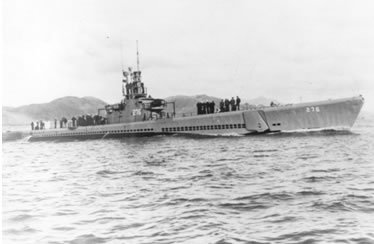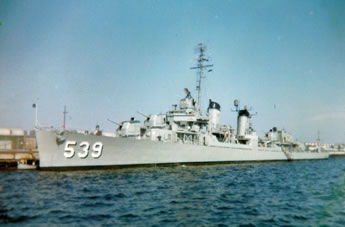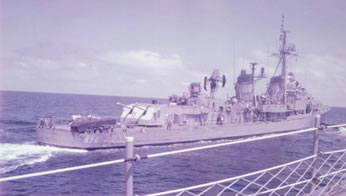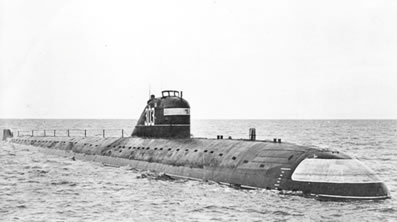(As printed in the Spring 2019 issue of Tin Can Sailors, magazine.)
I marvel at the way this was revealed to me. I marvel at the way our Navy works without tipping its hand. The first of several dots connecting this story began in 1949. As twelve year olds, we were at a family friend’s wedding, the festivities held at the Allen Center Officer’s Club, Long Beach Naval Station. The reception was in full swing and John, younger brother of Joan, the bride, and I had no idea what all the whooping and hollering was about. So, we ducked out and went to explore the Long Beach Naval Station. At about 2015, on a clear balmy evening, we walked under a full moon down to the quay wall. We had the place to ourselves. The United States was four years into a relaxing peacetime and our mouths were soon agape as we passed American warships, fast asleep, their exhaust blowers softly humming.
At length, we stumbled on a lone submarine. Except for distant music from Joan’s wedding, it was quiet. We walked the submarine’s length and drew up to the brow. Water lapped at her hull. A gull squawked. The moon was almost overhead, illuminating us, as if we were on stage.
A voice called from the bridge. “What are you fellas up to?”
“Just looking, sir,” we mumbled.
“You wanna come aboard?” was the reply.
“Sure.”
“Well, come on over.”
So, we scrambled over the brow and to the base of the conning tower where the Sailor in a pea coat looked down to us. After a moment, he gestured us up a ladder.
Soon we joined this bored second class quartermaster, standing a lonely OOD watch while listening wistfully to Joan’s wedding music from the distant Allen Center.
Yes, we confirmed that we were part of the wedding family but then the talk turned to the Navy and what this submarine was all about. I recall that she was the USS Sawfish (SS 276) (I learned later she was a Gato class) credited with sinking 97,848 tons of enemy shipping. Somehow, the discussion turned to something I had heard a lot about: Sonar. What is that?

After a rudimentary discussion of electronic wonders, our host added, “… stuff’s coming out that’s so powerful they can hear ships coming out of Japan.”
“Un huh.” That sounded good, but it went way over my head.
We blubbered excitedly to our parents when we got back to the party. And the next day, phone calls were made. The following day, we had a complete tour of the Sawfish from stem to stern. But I put down that quartermaster’s remark as excessive enthusiasm laced with some Buck Rogers gobble-de-gook.
As a senior midshipman In the NROTC at USC, I put in for destroyers.
The “…Greyhounds of the Sea” were in great demand in those days to oppose the massive (later disclosed as contrived) Soviet submarine threat of over 400 submarines.
I was accepted and received orders to the USS Tingey (DD 539), a venerable Fletcher class tin can.
Early on, during a shipyard availability, they sent me to ASW school, a three week course. Next, they sent me to the gun-fire control officer’s school, another three weeks.

It wasn’t until recently that I realized the Navy had done an excellent job in preparing me for what was to come. Even in NROTC we learned and practiced the fundamentals of navigation, seamanship, and steaming in company. In ASW school, we learned those fundamentals and practiced them in the attack trainer. Later, we went to sea and practiced with a real submarine, ASW students alternating between the bridge, CIC, sonar, and the fantail where we got to throw hand grenades over the side simulating depth charge attacks.
Then the Tingey went on a WestPac deployment and found herself steaming with the USS Rogers (DDR 876) heading to join up with the Seventh Fleet in the South China Sea.
We had just refueled in Okinawa’s Buckner Bay and were ready to turn south when we received a message, I believe originating from CINCPAC, to continue heading east to a certain lat/long and search for a submarine.
“Huh?” Okay. So, we headed about ninety miles east. We were unbelieving. How the hell would some goldbrick, his feet propped on a desk in Hawaii, know about a submarine thousands of miles away?
But two hours later, I was in sonar (on a Fletcher class Can, the sonar space –“sonar shack” – is a space about five by eight just behind the bridge. At general quarters, five or six guys are stuffed in there) trying to do their jobs.
As usual, the speaker on the sonar “stack” was on. I heard, “…ping…..ping …..ping.” Then, “Ping …bloop.”
Jeez. That sounds like the real thing.
 As I slapped on earphones, our sonarman, he was very good, automatically began calling out sonar bearings, ranges and classification. He called out, “Possible submarine.” Submarine classification is a big deal. If the sonarman or the ASW officer say possible, it means they are fairly certain the target being tracked is really a submarine, but not a positive submarine. But still, not enough evidence is there to say it’s actually a submarine. Even with that, everyone is on their toes. Trash talk and jocularity go to zero. Everybody gets serious.
As I slapped on earphones, our sonarman, he was very good, automatically began calling out sonar bearings, ranges and classification. He called out, “Possible submarine.” Submarine classification is a big deal. If the sonarman or the ASW officer say possible, it means they are fairly certain the target being tracked is really a submarine, but not a positive submarine. But still, not enough evidence is there to say it’s actually a submarine. Even with that, everyone is on their toes. Trash talk and jocularity go to zero. Everybody gets serious.
And with this one there was no argument. The contact sounded legit.
I called Bill, the OOD on the bridge. After a discussion with the captain, we went to GQ-1AS. Then the Rogers called over saying they had the same contact.
So, for the next three days, we sat atop that thing. It was trying to act like a bed of kelp. But the contact was not mushy, unlike a kelp bed or even a whale. It was solid and metallic. We tried to raise it on the UQC but no joy. He just sat there, drifting at three knots as if he really were a bed of kelp.
The afternoon of the third day found me in sonar and standing before the attack director. Dull, boring. Everything, same, same.
But then, zsssst, zsssst.
Target speed jumped to five knots. Then seven, then ten … fourteen…seventeen. The bridge watch, the OOD and the captain, didn’t believe I had a submarine contact that can do seventeen knots. Submarine’s don’t do that. They’re not that fast. They said my equipment must be faulty. The real problem was that the engineers, (the chief engineer) was angry they had to cut in superheaters to keep up with Gobbell’s “phony” contact.
“What?” the OOD screams. “You’re crazy. How fast is that thing going now?”
I checked the attack director. “Twenty-two knots, Bill”
“(unprintable)!” screams Bill.
I know Bill, He’s a neat guy. But a neat guy with a temper. And I know he’s out there on the bridge wing, face red, shouting at the chief engineer who is waving his arms to the captain and complaining about his beloved superheaters.
The captain, now in denial, agrees with the Chief Engineer. They send in ETs to check on my “faulty” equipment.
Meanwhile, the submarine was drawing ahead of us as our stalwart engineers figured out what to do about superheat.
 Three ETS muscled their way into the closet size sonar, already crowded with six guys, plunked massive tool chests on the deck and start opening the “stack” cabinet, an ancient SQS 4 sonar. One made to open my attack director.
Three ETS muscled their way into the closet size sonar, already crowded with six guys, plunked massive tool chests on the deck and start opening the “stack” cabinet, an ancient SQS 4 sonar. One made to open my attack director.
Tersely, I said, “Not now.” I’m a lieutenant j.g g. He’s a petty officer. I am an officer and in command of the space.
With a grunt, he moved off.
But the sound is still on. I clearly hear the contact. I hear machinery noises down there. I hear their captain belching. I hear the ship’s cat screeching. I mean that Communist submarine is the noisiest thing I’ve ever heard. It has more pops and scratches than an ancient 78 record.
The OOD and I are still arguing on the command circuit. The ETs have circuit drawings all over the deck. The chief engineer is yelling at the captain who is undecided.
Our saving grace was a P2V Neptune out of Kadena Air Force Base, Okinawa. He blasted right over the top of us, his R 3350 engines thundering. He then flew out on the vector we provided. Almost right away, I heard the loudspeaker in CIC announce “Madman!”
It was the P2V guy. Wow! That means the P2V’s magnetic anomaly gear (MAD) picked up the submarine. With a MAD contact, the classification is always “positive” submarine.
Without a word, the ETs closed the sonar cabinet, picked up their tool boxes, and marched out. The chief engineer was contrite. So was the captain. We soon went to twenty-seven knots and caught up with Ivan.
The P2V kept it up, dropping sonobuoys and harassing that Commie.
All smiles aboard the Tingey. Everyone thought I was Father Christmas.
We broke contact the next day when the submarine parked under a Soviet trawler that conveniently showed up. As the trawler dumped garbage in his wake, we flipped each other the most gracious and well thought out signs of respect and headed south.
We pulled into Subic Bay a few days later and ONI was all over us. They confiscated our tapes and logs, interviewed our people and then departed. But later, they leaked the word back to us that our contact was a Soviet November class nuclear submarine, the first one discovered in the Pacific.
A nuke. Wow! That was 1962.
I felt pretty smug. We had the upper hand all the way in spite of our stupid arguing. But I later read up on Soviet November class submarines; that they carried two nuclear tipped torpedoes.
Not nice.
I dramatized this incident in my latest novel, Dead Man Launch. Also, while researching that book, I learned of another incident that occurred in 1968 and used it also. Here’s how it went:
During the North Korean seizure of the USS Pueblo (AGER 2), tensions were high. We had surrounded the Korean Peninsula with three aircraft carriers. Then the Russians dispatched four submarines out of Vladivostok, to harass and possibly sink our carriers, four hundred miles south.
From Hawaii, a secret naval facility named KSOCK1 detected those submarines. In turn, KSOCK advised, among others, CNO, SECDEF, and the State Department of the threat. A recommendation was sent to the White House who immediately sent a démarche to the Russians telling them to turn their submarines around or that we would sink them.
Within two hours, the Russians turned their submarines around and sent them back to Vladivostok.
True story.2
While drafting Dead Man Launch, it occurred to me that I’d seen a very small part of one of our Navy’s great triumphs before, during, and well after my active duty: SOSUS. An acronym for SOund SUrveillance System. Highly classified at first, it was and still is a network of seafloor mounted microphones that detect man-made objects and transmit the raw data to a shore-side collection station. These microphone networks, now very sophisticated, are in all the world’s major oceans and littorals as well. In recent years, the Russians have developed their own network. Secretly, they plow up and destroy our cabling. We plow up theirs. Tit for tat.
Thus, it occurred to me in the last couple of years that this SOSUS stuff had been going on for decades and I realized that an innocent conversation aboard the Sawfish in 1949, true or not true, was a very, very small peek into the future. And without thinking about it until recently, it also occurred to me that that Russian nuke we held down in 1962 off Okinawa, had been noisy enough for our SOSUS people to detect, track, and to ultimately direct us to the contact. Their fear, I believe, was that, with nuclear power, the Russian could steam all the way south and harass our carrier(s) in the South China Sea. And later, in 1968, I’m guessing Admiral Shaefer’s contact, although not revealed in the article, came to him at KSOCK via SOSUS.
I’ve connected the dots to an amazing story. At least I hope it’s right. An astounding technology. Unlike the other services, our Navy did not boast or brag about this wonderful tool. Nor most of the other tools currently in inventory, past or present. And an unwitting LTJG Gobbell was a benefactor of this remarkable technology.
Bravo Zulu, Navy.
1KSOCK — Kunia Regional Signals Intelligence Center. An enormous 250,000 ft² facility built right after the Pearl Harbor attack. Kunia is an area on Oahu’s north side originally Intended as an aircraft assembly center. But after determining mainland aircraft plants could take care of all that, they soon turned it over to map making and the ever-expanding fleet intelligence center. Since hardened and underground, KSOCK still serves the fleet today as the Pacific Intelligence Center
2“We Will Sink Them,” U.S. Naval Institute Proceedings, October, 2012, pp 60; Edward D Sheafer, ADM, USN (ret.)
